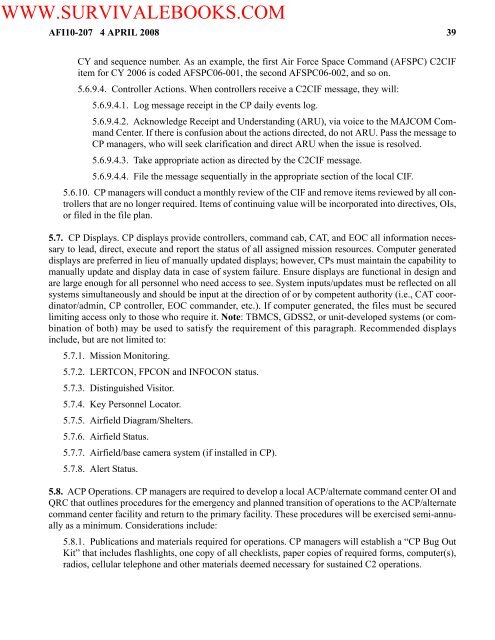2004 US Air Force OPERATIONAL REPORTING ... - Survival Books
2004 US Air Force OPERATIONAL REPORTING ... - Survival Books
2004 US Air Force OPERATIONAL REPORTING ... - Survival Books
You also want an ePaper? Increase the reach of your titles
YUMPU automatically turns print PDFs into web optimized ePapers that Google loves.
WWW.SURVIVALEBOOKS.COMAFI10-207 4 APRIL 2008 39CY and sequence number. As an example, the first <strong>Air</strong> <strong>Force</strong> Space Command (AFSPC) C2CIFitem for CY 2006 is coded AFSPC06-001, the second AFSPC06-002, and so on.5.6.9.4. Controller Actions. When controllers receive a C2CIF message, they will:5.6.9.4.1. Log message receipt in the CP daily events log.5.6.9.4.2. Acknowledge Receipt and Understanding (ARU), via voice to the MAJCOM CommandCenter. If there is confusion about the actions directed, do not ARU. Pass the message toCP managers, who will seek clarification and direct ARU when the issue is resolved.5.6.9.4.3. Take appropriate action as directed by the C2CIF message.5.6.9.4.4. File the message sequentially in the appropriate section of the local CIF.5.6.10. CP managers will conduct a monthly review of the CIF and remove items reviewed by all controllersthat are no longer required. Items of continuing value will be incorporated into directives, OIs,or filed in the file plan.5.7. CP Displays. CP displays provide controllers, command cab, CAT, and EOC all information necessaryto lead, direct, execute and report the status of all assigned mission resources. Computer generateddisplays are preferred in lieu of manually updated displays; however, CPs must maintain the capability tomanually update and display data in case of system failure. Ensure displays are functional in design andare large enough for all personnel who need access to see. System inputs/updates must be reflected on allsystems simultaneously and should be input at the direction of or by competent authority (i.e., CAT coordinator/admin,CP controller, EOC commander, etc.). If computer generated, the files must be securedlimiting access only to those who require it. Note: TBMCS, GDSS2, or unit-developed systems (or combinationof both) may be used to satisfy the requirement of this paragraph. Recommended displaysinclude, but are not limited to:5.7.1. Mission Monitoring.5.7.2. LERTCON, FPCON and INFOCON status.5.7.3. Distinguished Visitor.5.7.4. Key Personnel Locator.5.7.5. <strong>Air</strong>field Diagram/Shelters.5.7.6. <strong>Air</strong>field Status.5.7.7. <strong>Air</strong>field/base camera system (if installed in CP).5.7.8. Alert Status.5.8. ACP Operations. CP managers are required to develop a local ACP/alternate command center OI andQRC that outlines procedures for the emergency and planned transition of operations to the ACP/alternatecommand center facility and return to the primary facility. These procedures will be exercised semi-annuallyas a minimum. Considerations include:5.8.1. Publications and materials required for operations. CP managers will establish a “CP Bug OutKit” that includes flashlights, one copy of all checklists, paper copies of required forms, computer(s),radios, cellular telephone and other materials deemed necessary for sustained C2 operations.
















